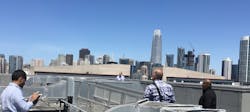$110M funding NYC-NJ Multifamily Housing Virtual Power Plant effort
Digital energy efficiency and demand response technology firm Logical Buildings has received a $110 million commitment from investment firm Keyframe Capital to fund virtual power plant (VVP) projects in New York City and New Jersey multi-family residential buildings.
The $110M VPP facility can be repaid through energy savings and grid revenue. Logical Buildings will work to integrate its GridRewards and SmartKitAI tools to activate demand response opportunities for the facilities.
Those participating NYC and NJ multifamily housing sites can use these to deploy connected smart thermostat upgrades which integrate with the Logical Building tools. The building’s smart meters were recently installed by utility Con Edison as part of its $2 billion infrastructure investments.
The GridRewards and SmartKit AI platforms would link to each apartment’s smart thermostat and record data in 15-minute increments, generating potential grid services revenues. The energy efficiency and demand response tools also would reduce carbon emissions, the company says.
With Connectivity comes Cybersecurity Concerns: Sign up for Dragos' Year in Review Report
Watch our free Webinar on OT Asset Visbility and Cybersecurity with Dragos
Register for our EnergyTech free E-Book
Navigating the Energy Transition: The Digital, Efficiency and Grid Edge Series
“Imagine providing residents with smart thermostats that reduce building energy usage, lower resident utility bills, and generate cash rewards, while simultaneously enhancing comfort and convenience. With our new project facility this is now a reality,” said Jeff Hendler, CEO at Logical Buildings. “The multifamily market remains largely untapped when it comes to impactful decarbonization and energy transition projects. Our project facility provides building owners with access to new opportunities to create thousands of grid-connected smart apartments at once, instead of the traditional ‘one home at a time’ approach to residential energy savings.”
Building energy use accounts for close to 35 percent of greenhouse gas emissions the U.S. but as much as 70 percent in a dense city such as New York, according to various reports. Virtual power plants can utilize energy storage at a time when demand is lower and then redistribute that additional electricity back into the grid during times of peak demand, reducing pressure on the utility systems.
With New York City’s council-approved Climate Modernization Act going into effect next year, every kWh and therm used by multifamily housing will count against new carbon emissions caps. Some 50,000 NYC buildings are subject to the new legislation which can penalize properties and owners for not meeting greenhouse gas reduction goals.
About the Author
EnergyTech Staff
Rod Walton is senior editor for EnergyTech.com. He has spent 17 years covering the energy industry as a newspaper and trade journalist.
Walton formerly was energy writer and business editor at the Tulsa World. Later, he spent six years covering the electricity power sector for Pennwell and Clarion Events. He joined Endeavor and EnergyTech in November 2021.
He can be reached at [email protected].
EnergyTech is focused on the mission critical and large-scale energy users and their sustainability and resiliency goals. These include the commercial and industrial sectors, as well as the military, universities, data centers and microgrids.
Many large-scale energy users such as Fortune 500 companies, and mission-critical users such as military bases, universities, healthcare facilities, public safety and data centers, shifting their energy priorities to reach net-zero carbon goals within the coming decades. These include plans for renewable energy power purchase agreements, but also on-site resiliency projects such as microgrids, combined heat and power, rooftop solar, energy storage, digitalization and building efficiency upgrades.
